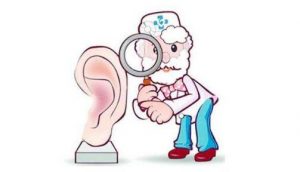
Why do you want to proceedNewborn hearing screening?
Congenital hearing loss is one of the most common birth defects. Its incidence rate is as high as 1‰~3‰, 2-3 million is born every year, and the hearing loss of 0-6 is mainly severe and extremely severe. . It ranks first in all newborns. Hearing loss in neonates and infants can affect the speech, cognition and emotional development of children. In severe cases, it can lead to hoarseness and impose a heavy burden on families and society. Through regular physical examinations or parental observations, hearing impairment is generally found after the age of 2 in children, and the period of rapid development of children’s language is missed, delaying the best time for recovery. Neonatal hearing screening can detect congenital hearing loss early, and make it return to the mainstream society through early intervention and early rehabilitation.

Newborn hearing screening
1, normal newborn screening is completed before 48 hours of birth to the time of discharge, and those who fail the primary screening or missed screening are re-screened around 42 days after delivery. Screening methods primarily use transient evoked otoacoustic emissions (TEOAE) or distortion product otoacoustic emissions (DPOAE). If the rescreening has not passed, it is necessary to refer to the Children’s Hearing Diagnostic Center for hearing diagnosis within 3 months.
2 and NICU neonatal screening were performed before discharge from the hospital. The screening method used automatic auditory brainstem response (AABR) or combined otoacoustic emissions (OAE) and AABR screening to avoid missed diagnosis of auditory neuropathy. Those who fail to pass the screening are not screened, but are referred directly to the Children’s Hearing Diagnostic Center for hearing diagnosis within three months. Because NICU newborns mostly have high risk factors for hearing loss and have the possibility of delayed hearing loss, even if hearing screening is passed, hearing should be checked every six months to one year, at least 3 years old.
What is neonatal deafness genetic screening?
Neonatal deafness genetic screening is the collection of cord blood or heel blood at the time of birth or 3 days after birth to screen for deafness and common genes. A common method currently used is to use the deafness gene chip to screen 2 common mutation sites of GJB26, SLC4A12, mitochondrial 3SrRNA and GJB9 genes. It can early detect high-risk children with delayed hearing loss caused by mutations in deafness, as well as drug-induced deafness-sensitive children, thus achieving early diagnosis and early warning, which is an effective supplement to newborn hearing screening.

Common deafness susceptibility genes are mainly the following three
Mutations in the 1 and GJB2 genes can cause severe sensorineural hearing loss or delayed hearing loss.
Mutations in the 2 and SLC26A4 genes can cause large vestibular aqueduct syndrome, which is characterized by progressive and fluctuating hearing loss.
3, a mitochondrial 12SrRNA gene mutation, can lead to drug-sensitive deafness.
What should I do if my newborn hearing screening fails?
(1) Screening
Two-stage screening is carried out: the health care institution carries out the initial screening after XINX-2 days after the birth of the newborn, and the unsuccessful screening is performed within 5 days after birth, on the premise of informed consent and informed choice of the newborn guardian. Those who have not yet passed should be referred to a tertiary hospital with eligibility for neonatal disease (hearing) testing. For key screening subjects, even through screening, the infant’s guardian should be informed of 42 visits every 3 months during 6 years. The follow-up findings should be promptly referred for diagnosis and treatment.
(2) Diagnosis and evaluation:
Instrument evaluation: review the failed baby, in the 2 ~ 3 months of birth, to the third-level hospital with neonatal disease (hearing) testing for otolaryngology examination and acoustic impedance, otoacoustic emissions, auditory brainstem Evoked potential detection, behavioral audiometry and other related examinations, as well as medical and imaging examinations, are generally diagnosed and evaluated at 6 months of age, to determine the extent of hearing loss and the areas that cause hearing loss and possible causes.
(three) treatment and intervention
1, treatment: A tertiary hospital with a qualification for neonatal disease (hearing) is responsible for treating the cause of hearing impairment in children with hearing impairment.
2, Hearing Compensation or Reconstruction: For children diagnosed with sensorineural deafness, a tertiary hospital with eligibility for neonatal disease (hearing) is instructed to perform the following early interventions:
(1) Choose to wear hearing aids: For children with residual hearing (light-to-severe hearing impairment), appropriate hearing aids should be selected according to relevant standards for hearing correction;
(2) cochlear implant: for children with severe and very severe cochlear sensory neurological deafness, cochlear implant can be performed if conditions permit;
(3) Hearing and language training: After wearing a hearing aid or implanting a cochlear implant, arrange the subject to the relevant rehabilitation institution for appropriate hearing-language rehabilitation training and family rehabilitation guidance to promote hearing and language development of the deaf child.
Classification and classification of deafness 1 deafness classification
The average speech frequency pure tone hearing threshold is divided into 1980 levels according to the WHO5 year ear grading standard.
Mild sputum: The audiometer checks the pure tone and the language listening threshold from 26 to 40dB.
Moderate 聋: hearing threshold 41 ~ 55dB
Medium and severe 聋: hearing threshold 56 ~ 70dB.
Severe 聋: hearing threshold 71 ~ 91dB.
Full 聋: Pure tone audiometry threshold exceeds 91dB.
Classification of 2 ear tags
According to the location and nature of the lesion can be divided into three categories.
Conductive sputum: lesions occur in the external ear, middle ear sound transmission mechanism, and sound waves are transmitted to the inner ear, such as deafness caused by sputum embolism and otitis media.
Sensorineural hearing loss: refers to the lesions of the cochlear spiral, can not turn the sound waves into nerve excitation or the nerve and its central pathways can not cause the nerves to be excited; or the cerebral cortical central lesions can not distinguish the language, collectively known as sensorineural hearing loss.
Mixed 聋: both the sound and the sensory mechanism have lesions at the same time
Jinghao medical hearing aid reminder: hearing aids need to be professionally “fitted”, it is very important to choose a professional hearing aid fitting center and hearing aid fittings! All patients and friends have any hearing problems can call the Jinghao medical consultation, or personally Come to the fitting center experience. Hearing aid free consultation phone: +86-18566295705
You can also scan our WeChat public account for more information about hearing.

Link:Importance of newborn hearing screening
REF: Hearing aids China, ITE hearing aids, Digital Hearing AidsThe article comes from the Internet. If there is any infringement, please contact [email protected] to delete it.



